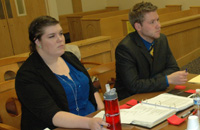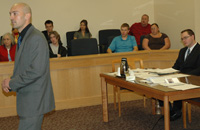Students Learn by Doing in Evidence/Trial Practice
February 9, 2012

Every fall semester, Professor Barbara Bergman leads students in a unique learning-by-doing opportunity when she combines two law school staples into one course: Evidence and Trial Practice.
This six-credit course is not for the faint-hearted. Evidence and Trial Practice, or ETP as it is called, prepares students for life as a trial lawyer. “They live and breathe this class,” said Professor Bergman, who also is associate dean for academic affairs at the University of New Mexico School of Law. “The goal is to teach them the rules of evidence and how they work, and then they have to apply the rules every week in small group breakout sessions.”
Professor Bergman guides students through each stage of a trial, from preparing opening statements to examining witnesses during a trial to closing arguments. Throughout the semester, all the students work on the same case file; last fall it was State v. Diamond, a first-degree murder case. Professor Bergman lectures and provides demonstrations to the entire class three times a week for 14 weeks.

In addition to those full classes, the students also attend a two-hour breakout session one night each week consisting of no more than eight students. In those small groups, they practice the various trial skills covered in the combined class. To help make it as realistic as possible, the students are expected to dress for court and the exercises are held in the mock trial rooms at the law school.
“What makes this class effective is that each lesson builds on the previous lesson, requiring students to understand the rules of evidence and apply them in a trial setting,” said Professor Bergman. “By learning the underlying rationale behind the rules, they are able to respond to objections and make persuasive arguments to the court.”
Adjunct Faculty Indispensable
Adjunct Faculty for Evidence/Trial Practice
Fall 2011
Brent Bailey
Mary Behm (`99)
The Honorable Charlie Brown (`85)
The Honorable Neil Candelaria (`86)
Mary Carmack (`05)
The Honorable Edward Chavez (`81)
The Honorable Jim Hall
Kathy Love
Elicia Montoya (`99)
Nicole Moss (`05)
Cammie Nichols
Carlos Obrey-Espinoza (`01)
Peter Schoenburg
Steven Scholl (`89)
The Honorable Linda Vanzi (`95)
Dick Winterbottom
Professor Bergman could not provide the detailed hands-on learning experience to students without the assistance of 16 adjunct professors, all practicing trial lawyers or judges, many of whom took the class as UNM law students. Even the highest level of the state’s judiciary was represented last fall by Supreme Court Justice Edward Chavez (`81). The adjunct faculty team up on a revolving schedule to work with different groups of students during the practice sessions. The feedback they provide to the students is invaluable.
In addition, for the fall 2011 ETP course, forensic pathology fellows from the medical school, under the supervision of Dr. Michelle Aurelius from the Office of the Medical Investigator, served as expert witnesses. “This was a great opportunity to teach the students the importance of good experts,” said Professor Bergman.
In addition to the live critique provided by the adjunct faculty, throughout the semester, all practice sessions are recorded, providing an ongoing file of each student’s progress. The students then meet with Professor Bergman to review the recordings of their performances. In preparation for the final trial, the students also prepare a trial notebook, which is the basis for a portion of their final grade in the class.

The Final Trial
The culmination of the trial practice component of the course occurs on the Saturday before Thanksgiving when the entire class of up to 64 students appears for trial at the Second Judicial District Courthouse in downtown Albuquerque. Chief Judge Ted Baca permits the class to use the courthouse for the entire day. Promptly at 8:30 a.m., 16 mock trials begin, complete with a real judge, witnesses, jurors and bailiff/critiquers. The trials usually conclude by mid-afternoon when the jurors retire to deliberate. The jury deliberations are then taped for the students to review later.
Most law schools offer evidence and trial practice as separate courses, but, in 1972, Professor Leo Romero, at the urging of former Dean Fred Hart, saw the value of combining the two subjects into one course so students could immediately put into practice the concepts they were learning.
“The summer before I joined the UNM law faculty, I attended the very first National Institute for Trial Advocacy (NITA) training program. NITA changed the way trial advocacy is taught by focusing on simulated trial exercises that students perform, followed by constructive critiques by experienced trial lawyer/teachers,” said Professor Romero, who taught the course until the late-1980s, at which time he moved into law school administration. At that time, Professor Bergman took over the course and has been teaching it ever since.
“Being able to watch the students as they struggle at the beginning to learn the evidence rules and trial techniques and then develop their skill and confidence as the semester progresses makes this one of the most rewarding classes I have ever taught,” said Professor Bergman. “Besides, I get to keep learning as well from the tremendously talented adjunct faculty who make this course possible.”
